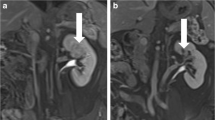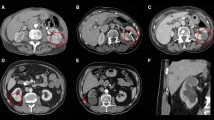Abstract
Introduction
To retrospectively evaluate the mid-term outcomes of percutaneous radiofrequency ablation (RFA) with multitined expandable electrodes externally cooled with saline solution in patients with T1a renal cell carcinoma (RCC).
Materials and methods
In this retrospective study, we evaluated 39 RCC in 35 patients treated with CT-guided RFA in 41 procedures (2011–2017). All patients were staged T1a, N0, M0 prior to RFA. Mean tumor size was 24.48 mm. A 4-tined expandable RFA electrode cooled with pump-circulating saline was used. Efficacy was evaluated verifying complete tumor necrosis (no contrast enhancement on imaging) at the end of the procedure and on subsequent controls. Follow-up observation period was 5 years. Minor/major complications, hospitalization days, serum creatinine and GFR pre- and post-RFA (compared using paired t test) and post-operative pain (evaluated with NRS after treatment) were considered as safety indicators. Overall survival was also calculated (Kaplan–Meier method).
Results
Of 35 patients, 30/35 had 1 treatment (primary effectiveness rate 86%), 4/35 had 2 treatments and 1/35 had 3 treatments for residual disease. There were no relapses and no mid-long-term complications; 3 minor (8%) and 1 major (2.7%) complications during perioperative period were reported. Mean before and after RFA serum creatinine rates were, respectively, 1.08 mg/dl and 1.11 mg/dl (p value: 0.4117). NRS median value is 0.8. Hospitalization days median value is [2.8 ± 1.9] days. 91.4% of all patients survived, with a median overall survival time of 65 months.
Conclusions
Mid-term results show that CT-guided RFA with multitined expandable electrodes externally cooled with saline solution is an effective and safe treatment in patients with RCC-staged T1aN0M0. Data reported in our study are in line with data reported in the literature from patients treated with other devices.






Similar content being viewed by others
References
Guidelines For Renal Tumors (2016) AIOM (Italian Association of Medical Oncology)
Ridge CA, Pua BB, Madoff DC (2014) Epidemiology and staging of renal carcinoma. Semin Interv Radiol 31:3–8. https://doi.org/10.1055/s-0033-1363837
Ng CS, Wood CG, Silverman PM et al (2008) Renal cell carcinoma: diagnosis, staging, and surveillance. AJR Am J Roentgenol 191:1220–1232. https://doi.org/10.2214/AJR.07.3568
Gervais DA, McGovern FJ, Arellano RS et al (2005) Radiofrequency ablation of renal cell carcinoma. Indications, results, and role in patient management over a 6-year period and ablation of 100 tumors. AJR Am J Roentgenol 185:64–71
Zagoria RJ, Hawkins AD, Clark PE et al (2004) Percutaneous CT-guided radiofrequency ablation of renal neoplasms: factors influencing success. AJR Am J Roentgenol 183:201–207. https://doi.org/10.2214/ajr.183.1.1830201
Chow WH, Devesa SS, Warren JL, Fraumeni JF Jr (1999) Rising incidence of renal cell cancer in the United States. JAMA 281:1628–1631
Lee JH, You CH, Min GE et al (2007) Comparison of the surgical outcome and functional outcome between radical and nephron-sparing surgery for renal cell carcinoma. Korean J Urol 48:671–676. https://doi.org/10.4111/kju.2007.48.7.671
Van Poppel H, Da Pozzo L, Albrecht W et al (2011) A prospective, randomized EORTC phase 3 study comparing the oncologic out come of elective nephron-sparing surgery and radical nephrectomy for low-stage renal cell carcinoma. Eur Urol 59:543–552. https://doi.org/10.1016/j.eururo.2010.12.013
Fergany AF, Hafez KS, Novick AC (2000) Long-term results of nephron-sparing surgery for localized renal cell carcinoma: 10-year follow up. J Urol 163:442–445
Uzzo RG, Novick AC (2001) Nephron-sparing surgery for renal tumors: indications, techniques and outcomes. J Urol 166:6–18
Zagoria RJ (2004) Imaging-guided radiofrequency ablation of renal masses. Radiographics 24(Suppl 1):S59–S71
Kawamoto S, Solomon SB, Bluemke DA et al (2009) CT and MR imaging appearance of renal neoplasms after radiofrequency ablation and cryoablation. Semin Ultrasound CT MR 30:67–77
Farrell MA, Charboneau WJ, DiMarco DS et al (2003) Imaging-guided radiofrequency ablation of solid renal tumors. AJR Am J Roentgenol 180:1509–1513
Gervais DA, McGovern FJ, Wood BJ et al (2000) Radio-frequency ablation of renal cell carcinoma: early clinical experience. Radiology 217:665–672
Spreafico C, Nicolai N, Lanocita R et al (2012) CT-guided percutaneous cryoablation of renal masses in selected patients. Radiol Med 117(4):593–605. https://doi.org/10.1007/s11547-011-0742-1
Goldberg SN, Gazelle GS, Compton CC et al (2000) Treatment of intrahepatic malignancy with radiofrequency ablation: radiologic-pathologic correlation. Cancer 88:2452–2463
Russo U, Maestroni U, Papapietro RV et al (2018) Imaging after radiofrequency ablation of renal tumors. Future Oncol 14:2915–2922
Cardella JF, Kundu S, Miller DL et al (2009) Society of interventional radiology clinical practice guidelines. J Vasc Interv Radiol 20(7 Suppl):S189–S191
Ferlay J, Steliarova-Foucher E, Lortet-Tieulant J et al (2013) Cancer incidence and mortality patterns in Europe: estimates for 40 countries in 2012. Eur J Cancer 49:1374–1403
Tsui KH, Shvarts O, Smith RB et al (2000) Renal cell carcinoma: prognostical significance of incidentally detected tumors. J Urol 163:426–430
Patard JJ, Rodriguez A, Rioux-Leclercq N et al (2002) Prognostic significance of the mode of detection in renal tumors. BJU Int 90:358–363
Herr HW (1999) Partial nephrectomy for unilateral renal carcinoma and a normal contralateral kidney: 10-year follow-up. J Urol 161:33–35
Gill IS, Kavoussi LR, Lane BR et al (2007) Comparison of 1,800 laparoscopic and open partial nephrectomies for single renal tumors. J Urol 178:41–46
Park H, Byun SS, Kim HH et al (2010) Comparison of laparoscopic and open partial nephrectomies in T1a renal cell carcinoma: a Korean multi center experience. Korean J Urol 51:467–471
Zlotta AR, Wildschutz T, Raviv G et al (2007) Radiofrequency interstitial tumor ablation (RITA) is a possible new modality for treatment of renal cancer: ex vivo and in vivo experience. J Endourol 11:251–258
Campbell SC, Novick AC, Belldegrun A et al (2009) Guidelines for management of the clinical T1 renal mass. J Urol 182:1271–1279
Ljunberg B, Bensalah K, Canfield S et al (2015) EAU Guidelines on renal cell carcinoma: 2014 updates. Eur Urol 67:913–924
Clark TW, Millward SF, Gervais DA et al (2009) Reporting standards for percutaneous thermal ablation of renal cell carcinoma. J Vasc Interv Radiol 20(7 Suppl):S409–S416
Van Poppel H, Becker F, Cadeddu JA et al (2011) Treatment of localised renal cell carcinoma. Eur Urol 60:662–672
Young EE, Castle SM, Gorbatiy V et al (2012) Comparison of safety, renal function outcomes and efficacy of laparoscopic and percutaneous radiofrequency ablation of renal masses. J Urol 187:1177–1182
Lian H, Guo H, Zhang G et al (2012) Single center comparison of complication in laparoscopic and percutaneous radiofrequency ablation with ultrasound guidance for renal tumors. Urol 80:119–124
Trudeau V, Larcher A, Boehm K et al (2016) Comparison of post-operative complications and mortality between laparoscopic and percutaneous local tumor ablation for T1a renal cell carcinoma: a population-based study. Urology 89:63–68
Takaki H, Yamakado K, Soda N et al (2010) Midterm results of radiofrequency ablation versus nephrectomy for T1a renal cell carcinoma. Jpn J Radiol 28:460–468
Varkarakis IM, Allaf ME, Inagaki T et al (2005) Percutaneous radiofrequency ablation of renal masses: results at a 2-year mean follow up. JURO 174:456–460
Clark TWI, Malkowicx B, Stavropoulos SW et al (2006) Radiofrequency ablation of small renal cell carcinomas using multitined expandable electrodes: preliminary experience. J Vasc Interv Radiol 17:513–519
Breen DJ, Rutheford EE, Stedman B et al (2007) Management of renal tumors by image-guided radiofrequency ablation: experience in 105 tumors. Cardiovasc Intervent Radiol 30:936–942
Curry D, Pahujia A, Loan W et al (2018) Radiofrequency ablation of small renal masses: outcome, complications, and effects on renal functions. Curr Urol 11:196–200
Ito K, Soga S, Seguchi K et al (2017) Clinical outcomes of percutaneous radiofrequency ablation for small renal cancer. Oncol Lett 14:918–924
Zhou W, Arellano RS (2018) Thermal ablation of T1c renal cell carcinoma: a comparative assessment of technical performance, procedural outcome, and safety of microwave ablation, radiofrequency ablation, and cryoablation. J Vasc Interv Radiol 26:943–951
Dai W, Covarrubias D, Uppot R et al (2017) Image-guided percutaneous radiofrequency ablation of central renal cell carcinoma: assessment of clinical efficacy and safety in 31 tumors. J Vasc Interv Radiol 28:1643–1650
Wah TM, Irving HC, Gregory W et al (2014) Radiofrequency ablation (RFA) of renal cell carcinoma (RCC): experience in 200 tumours. BJU Int 113:416–428
Johnson BA, Sorokin I, Cadeddu JA (2019) Ten-year outcomes of renal tumor radio frequency ablation. J Urol 201:251–258
Filippiadis D, Mauri G, Marra P et al (2019) Percutaneous ablation techniques for renal cell carcinoma: current status and future trends. Int J Hyperthermia 36:21–30
Floridi C, De Bernardi I, Fontana F et al (2014) Microwave ablation of renal tumors: state of the art and development trends. Radiol Med 119(7):533–540. https://doi.org/10.1007/s11547-014-0426-8
Chang X, Liu T, Zhang F et al (2015) Radiofrequency ablation versus partial nephrectomy for clinical T1a renal-cell carcinoma: long-term clinical and oncologic outcomes based on a propensity score analysis. J Endourol 29:518–525
Olweny EO, Park SK, Tan YK et al (2012) Radiofrequency ablation versus partial nephrectomy in patients with solitary clinical T1a renal cell carcinoma: comparable oncologic outcomes at a minimum of 5 years of follow-up. Eur Urol 61:1156–1161
Regier M, Chun F (2015) Thermal ablation of renal tumors: indications, techniques and results. Dtsch Arztebl Int 112:412–418
De Filippo M, Bozzetti F, Martora R et al (2014) Radiofrequency thermal ablation of renal tumors. Radiol Med 119:499–511. https://doi.org/10.1007/s11547-014-0412-1
Author information
Authors and Affiliations
Corresponding author
Ethics declarations
Conflict of interest
Each author declares that he or she has no commercial associations (e.g., consultancies, stock ownership, equity interest, patent/licensing arrangement, etc.) that might pose a conflict of interest in connection with the submitted article.
Ethical approval
All procedures performed in studies involving human participants were in accordance with the ethical standards of the institutional and/or national research committee and with the 1964 Helsinki Declaration and its later amendments or comparable ethical standards.
Informed consent
Informed consent was obtained from all individual participants included in the study.
Additional information
Publisher's Note
Springer Nature remains neutral with regard to jurisdictional claims in published maps and institutional affiliations.
Rights and permissions
About this article
Cite this article
De Filippo, M., Ziglioli, F., Russo, U. et al. Radiofrequency ablation (RFA) of T1a renal cancer with externally cooled multitined expandable electrodes. Radiol med 125, 790–797 (2020). https://doi.org/10.1007/s11547-020-01175-1
Received:
Accepted:
Published:
Issue Date:
DOI: https://doi.org/10.1007/s11547-020-01175-1




